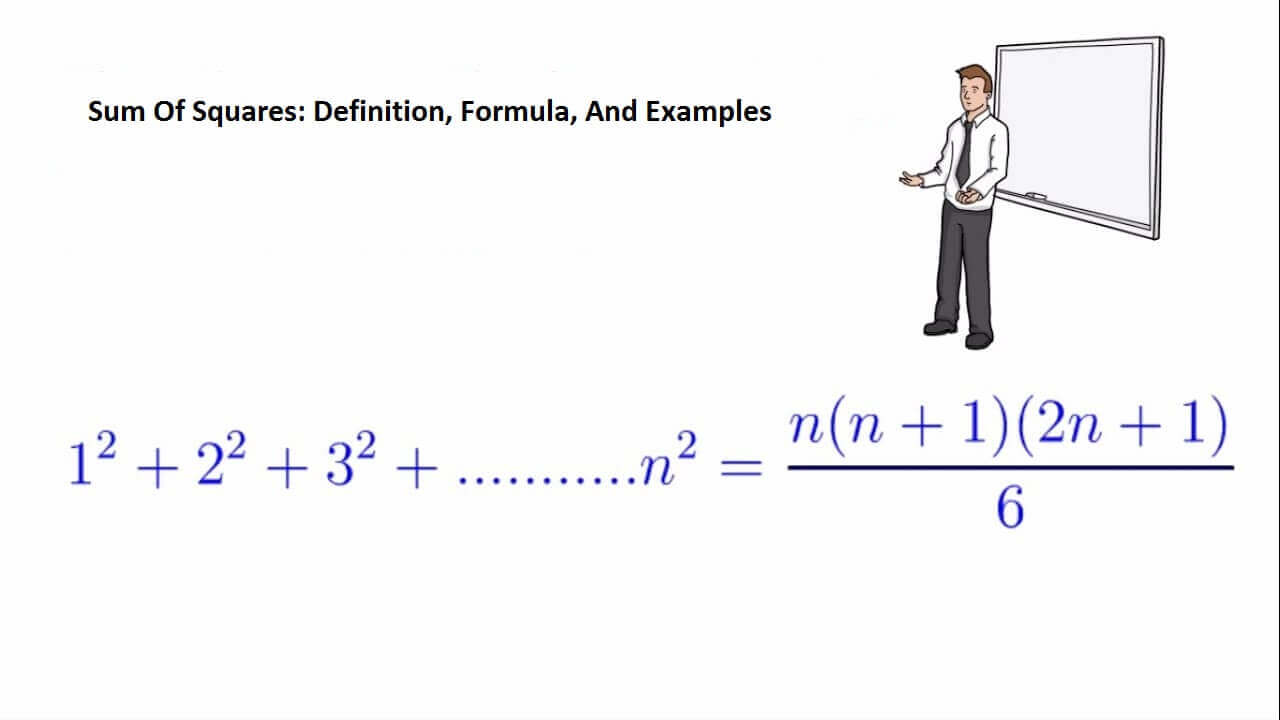The sum of squares is frequently used in mathematics and statistics. The sum of squares is usually used to find the dispersion of data points from the mean. While in mathematics, the sum of squares is used to find the sum of two or more squared numbers.
In this post, we will learn all the basics of the sum of squares along with a lot of examples.
What is the sum of squares?
The sum of squares is used to find the squared sum of two or more terms. The sum of squares can also be defined as the sum of squares of variation, where variation can be measured by the difference between each individual term and the mean.
In mathematics, take a set of data values and take a square of each data value and add them to get the sum of the squares. While in statistics, take the dataset and find its mean, then subtract each term of the dataset from the mean and find their sum, and add all the differences square.
The formula of the sum of squares
- The formula used to find the algebraic sum of squares is:
Sum of squares = a12 + a22 + a32 + a42 + … + an2
Sum of squares = ∑ an2
Where a1 + a2 + a3 + … are the terms of dataset.
- The formula used to find the statistical sum of squares is:
Sum of squares = (x1 – x̅)2 + (x2 – x̅)2 + (x3 – x̅)2 + (x4 – x̅)2 + … + (xn – x̅)2
Sum of squares = ∑ (xn – x̅)2
Where x1 + x2 + x3 + … are the terms of dataset.
How to calculate the sum of squares?
By using the formulas, the algebraic and statistical sum of squares can be calculated easily. Follow the below examples to learn how to calculate the sum of squares.
Example 1: For the Statistical sum of squares
Find the statistical sum of squares of the given set of data, 12, 22, 32, 44, 62, 74
Solution
Step 1: Take the given set of data.
12, 22, 32, 44, 62, 74
n = 6
Step 2: Find the mean of the given data set.
Mean = x̅ = (x1 + x2 + x3 + … + xn)/n
Mean = x̅ = (12 + 22 + 32 + 44 + 62 + 74)/ 6
Mean = x̅ = 246/6
Mean = x̅ = 123/3
Mean = x̅ = 41
Step 3: Now find the differences.
x1 – x̅ = 12 – 41 = -29
x2 – x̅ = 22 – 41 = -19
x3 – x̅ = 32 – 41 = -9
x4 – x̅ = 44 – 41 = 3
x5 – x̅ = 62 – 41 = 21
x6 – x̅ = 74 – 41 = 33
Step 4: Find the square of differences.
(x1 – x̅)2 = (-29)2 = (-29 * (-29)) = 841
(x2 – x̅)2 = (-19)2 = (-19 * (-19)) = 361
(x3 – x̅)2 = (-9)2 = (-9 * (-9)) = 81
(x4 – x̅)2 = (3)2 = (3 * 3) = 9
(x5 – x̅)2 = (21)2 = (21 * 21) = 441
(x6 – x̅)2 = (33)2 = (33 * 33) = 1089
Step 5: Take the general formula of the statistical sum of squares
Sum of squares = (x1 – x̅)2 + (x2 – x̅)2 + (x3 – x̅)2 + (x4 – x̅)2 + (x5 – x̅)2 + (x6 – x̅)2
Step 6: Put the square of differences in the above formula.
Sum of squares = (x1 – x̅)2 + (x2 – x̅)2 + (x3 – x̅)2 + (x4 – x̅)2 + (x5 – x̅)2 + (x6 – x̅)2
Sum of squares = 841 + 361 + 81 + 9 + 441 + 1089
Sum of squares = 2822
Example 2: For algebraic sum of squares
Find the algebraic sum of squares of the given set of data, 3, 5, 8, 11, 13, 16, 19
Solution
Step 1: Take the given set of data.
3, 5, 8, 11, 13, 16, 19
Step 2: Find the sum of each data value.
(3)2 = (3 x 3) = 9
(5)2 = (5 x 5) = 25
(8)2 = (8 x 8) = 64
(11)2 = (11 x 11) = 121
(13)2 = (13 x 13) = 169
(16)2 = (16 x 16) = 256
(19)2 = (19 x 19) = 361
Step 3: Take the general formula of the algebraic sum of squares.
Sum of squares = a12 + a22 + a32 + a42 + a52 + a62 + a72
Step 4: Put the square values in the formula.
Sum of squares = a12 + a22 + a32 + a42 + a52 + a62 + a72
Sum of squares = 32 + 52 + 82 + 112 + 132 + 162 + 192
Sum of squares = 9 + 25 + 64 + 121 + 169 + 256 + 361
Sum of squares = 1005
The above example can also be solved by using a sum of squares calculator to find the algebraic & statistical sum of squares in a fraction of seconds. Follow the below steps to use this calculator.
Step 1: Input the comma-separated data values.
Step 2: Press the calculate button.
Step 3: The algebraic and statistical sum of squares will show below the calculate button.
Step 4: Hit the show more button to view the step-by-step solution.
Example 3
Find the algebraic sum of squares of the given set of data, 4, 6, 9, 12, 14, 17, 20
Solution
Step 1: Take the given set of data.
4, 6, 9, 12, 14, 17, 20
Step 2: Find the sum of each data value.
(4)2 = (4 x 4) = 16
(6)2 = (6 x 6) = 36
(9)2 = (9 x 9) = 81
(12)2 = (12 x 12) = 144
(14)2 = (14 x 14) = 196
(17)2 = (17 x 17) = 289
(20)2 = (20 x 20) = 400
Step 3: Take the general formula of the algebraic sum of squares.
Sum of squares = a12 + a22 + a32 + a42 + a52 + a62 + a72
Step 4: Put the square values in the formula.
Sum of squares = a12 + a22 + a32 + a42 + a52 + a62 + a72
Sum of squares = 42 + 62 + 92 + 122 + 142 + 172 + 202
Sum of squares = 16 + 36 + 81 + 144 + 196 + 289 + 400
Sum of squares = 1162
Summary
Now you are witnessed that the sum of squares is not a difficult topic. In this post, we have discussed all the basics of the sum of squares. You can easily find the algebraic and statistical sum of squares just by learning the above post.


